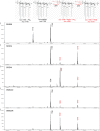Contribution of Novel Amino Acid Alterations in PmrA or PmrB to Colistin Resistance in mcr-Negative Escherichia coli Clinical Isolates, Including Major Multidrug-Resistant Lineages O25b:H4-ST131- H 30Rx and Non-x
- PMID: 29914952
- PMCID: PMC6125499
- DOI: 10.1128/AAC.00864-18
Contribution of Novel Amino Acid Alterations in PmrA or PmrB to Colistin Resistance in mcr-Negative Escherichia coli Clinical Isolates, Including Major Multidrug-Resistant Lineages O25b:H4-ST131- H 30Rx and Non-x
Abstract
Colistin is a last-line drug for multidrug-resistant Gram-negative bacteria. We previously reported four plasmid-mediated colistin resistance (mcr) gene-negative colistin-resistant Escherichia coli clinical isolates, including the major pathogenic and fluoroquinolone-resistant strains O25b:H4-ST131-H30Rx (isolates SRE34 and SRE44; MIC for colistin = 16 mg/liter), non-x (SME296; MIC = 8 mg/liter), and O18-ST416 (SME222; MIC = 4 mg/liter). In this study, we investigated the colistin resistance mechanism and identified novel amino acid substitutions or deletions in the PmrAB two-component system that activates eptA (encoding a phosphoethanolamine transferase) and arnT (encoding an undecaprenyl phosphate-alpha-4-amino-4-deoxy-l-arabinose arabinosyl transferase) in all colistin-resistant isolates. SRE34 possessed deletion Δ27-45 (LISVFWLWHESTEQIQLFE) in PmrB, SRE44 possessed substitution L105P in PmrA, and both SME222 and SME296 included substitution G206D in PmrB. Matrix-assisted laser desorption ionization-time of flight mass spectrometry revealed that lipid A is modified with phosphoethanolamine in all four isolates. Deletion of pmrAB decreased colistin MICs to 0.5 mg/liter and lowered eptA and arnT expression. Chromosomal replacement of mutated pmrA or pmrB in colistin-susceptible O25b:H4-ST131 strain SME98 (colistin MIC = 0.5 mg/liter) increased the colistin MIC to that of the respective parent colistin-resistant isolate. In addition, SME98 mutants in which pmrAB was replaced with mutated pmrAB showed no significant differences in bacterial growth and competition culture from the parent strain, except for the mutant with L105P in PmrA, whose growth was significantly suppressed in the presence of the parent strain. In conclusion, some O25b:H4-ST131 strains appear to acquire colistin resistance via phosphoethanolamine modification of lipid A through amino acid changes in PmrAB, and the amino acid changes in PmrB do not influence bacterial growth.
Keywords: Escherichia coli; PmrAB; antimicrobial resistance; bacterial infection; lipid A.
Copyright © 2018 American Society for Microbiology.
Figures




References
-
- Petty NK, Ben Zakour NL, Stanton-Cook M, Skippington E, Totsika M, Forde BM, Phan MD, Gomes Moriel D, Peters KM, Davies M, Rogers BA, Dougan G, Rodriguez-Bano J, Pascual A, Pitout JD, Upton M, Paterson DL, Walsh TR, Schembri MA, Beatson SA. 2014. Global dissemination of a multidrug resistant Escherichia coli clone. Proc Natl Acad Sci U S A 111:5694–5699. doi:10.1073/pnas.1322678111. - DOI - PMC - PubMed
-
- Croxall G, Hale J, Weston V, Manning G, Cheetham P, Achtman M, McNally A. 2011. Molecular epidemiology of extraintestinal pathogenic Escherichia coli isolates from a regional cohort of elderly patients highlights the prevalence of ST131 strains with increased antimicrobial resistance in both community and hospital care settings. J Antimicrob Chemother 66:2501–2508. doi:10.1093/jac/dkr349. - DOI - PubMed
-
- Chen L, Hu H, Chavda KD, Zhao S, Liu R, Liang H, Zhang W, Wang X, Jacobs MR, Bonomo RA, Kreiswirth BN. 2014. Complete sequence of a KPC-producing IncN multidrug-resistant plasmid from an epidemic Escherichia coli sequence type 131 strain in China. Antimicrob Agents Chemother 58:2422–2425. doi:10.1128/AAC.02587-13. - DOI - PMC - PubMed
Publication types
MeSH terms
Substances
LinkOut - more resources
Full Text Sources
Other Literature Sources
Medical
Research Materials

